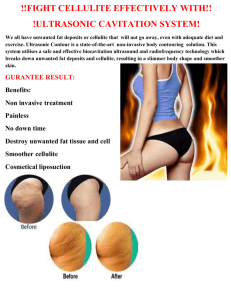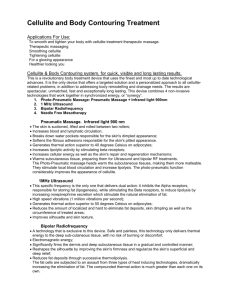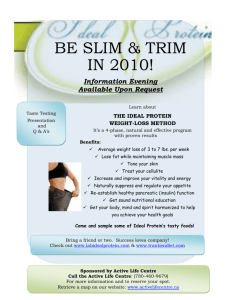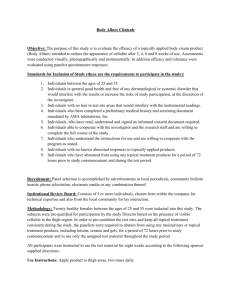Journal of Applied Medical Sciences, vol. 4, no. 4, 2015,... ISSN: 2241-2328 (print version), 2241-2336 (online)
advertisement
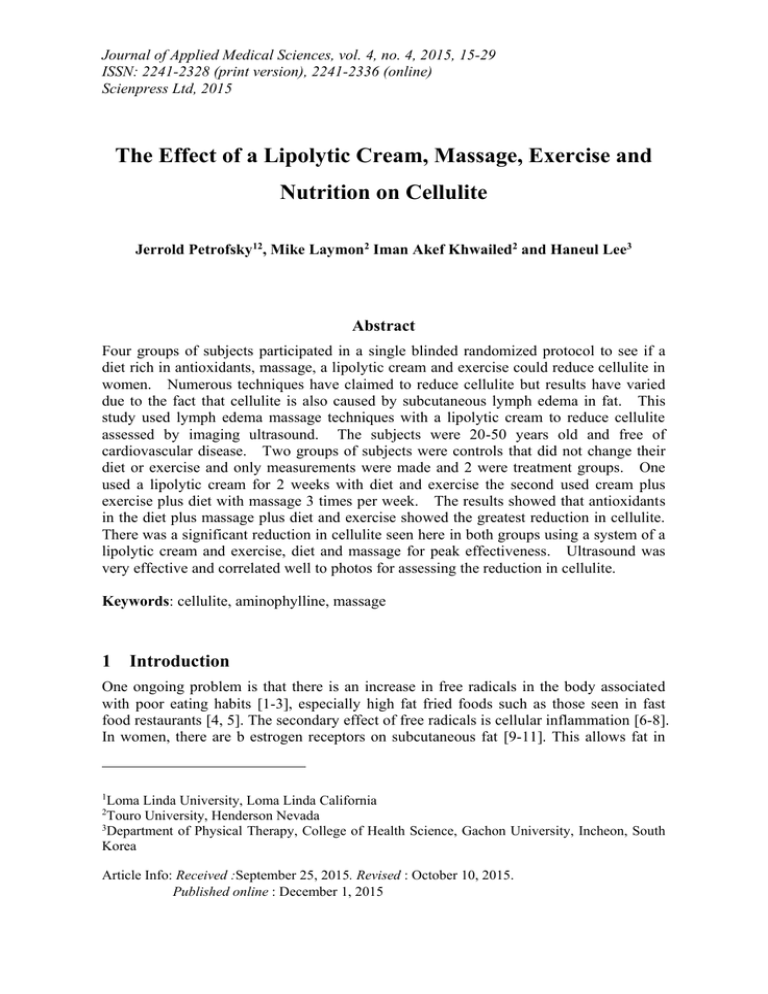
Journal of Applied Medical Sciences, vol. 4, no. 4, 2015, 15-29 ISSN: 2241-2328 (print version), 2241-2336 (online) Scienpress Ltd, 2015 The Effect of a Lipolytic Cream, Massage, Exercise and Nutrition on Cellulite Jerrold Petrofsky12, Mike Laymon2 Iman Akef Khwailed2 and Haneul Lee3 Abstract Four groups of subjects participated in a single blinded randomized protocol to see if a diet rich in antioxidants, massage, a lipolytic cream and exercise could reduce cellulite in women. Numerous techniques have claimed to reduce cellulite but results have varied due to the fact that cellulite is also caused by subcutaneous lymph edema in fat. This study used lymph edema massage techniques with a lipolytic cream to reduce cellulite assessed by imaging ultrasound. The subjects were 20-50 years old and free of cardiovascular disease. Two groups of subjects were controls that did not change their diet or exercise and only measurements were made and 2 were treatment groups. One used a lipolytic cream for 2 weeks with diet and exercise the second used cream plus exercise plus diet with massage 3 times per week. The results showed that antioxidants in the diet plus massage plus diet and exercise showed the greatest reduction in cellulite. There was a significant reduction in cellulite seen here in both groups using a system of a lipolytic cream and exercise, diet and massage for peak effectiveness. Ultrasound was very effective and correlated well to photos for assessing the reduction in cellulite. Keywords: cellulite, aminophylline, massage 1 Introduction One ongoing problem is that there is an increase in free radicals in the body associated with poor eating habits [1-3], especially high fat fried foods such as those seen in fast food restaurants [4, 5]. The secondary effect of free radicals is cellular inflammation [6-8]. In women, there are b estrogen receptors on subcutaneous fat [9-11]. This allows fat in 1 Loma Linda University, Loma Linda California Touro University, Henderson Nevada 3 Department of Physical Therapy, College of Health Science, Gachon University, Incheon, South Korea 2 Article Info: Received :September 25, 2015. Revised : October 10, 2015. Published online : December 1, 2015 16 Jerrold Petrofsky et al. the thigh area to be different than that seen in men. Chronic high free radicals in the body due to obesity or even cigarette smoking or high intake of high fat meals increase free radicals in the body[1, 12, 13]. This is especially the case in Asians where a genetic disposition occurs to high free radicals when ingesting a high fat meal [4, 5]. The combination of these estrogen beta receptors and free radicals causes a sustained inflammation, especially in the back of the thighs in women, that clogs lymph ducks and causes a sustain edema and fatty deposition called cellulite[14, 15]. Some recent studies show that massage of the area with gentle rolling can remove some cellulite [16-18]. Other studies show the use of high potency vitamins to remove cellulite while others use lipolytic creams[14, 15]. The present investigation combined these ideas to assess the best way of removing cellulite. The effect of different techniques was evaluated using imaging ultrasound. Lipases can remove subcutaneous fat [4, 19, 20](a cream compound applied to the skin). Diet and exercise was used in addition to the lipases to remove the fat from the body and cause a weight loss [21-31]. Mild exercise and diet have a beneficial effect on weight loss [21-31]. Diet and exercise also reduces free radicals [32]. As stated above, free radicals in women cause the fat on the thighs to become chronically inflamed causing a lymph edema. Thus a variety of treatments may help cellulite[33]. Therefore in the present investigation, we wanted to examine the effects of a diet and exercise program with a cream lipase plus lymph edema techniques used in physical therapy to see if we could reduce cellulite and cause weight loss. 2 Methods 2.1 Subjects The subjects in the study were 50people in the age range of 20 to 50 years old. The subjects were allfemale subjects and free of cardiovascular disease and neurological injuries. They had a BMI of between 20 and 40 and there is no restriction on height and weight. The subjects were divided into 4 groups. There were 2 investigational groups (G1 and G2) and 2 matching control groups (C1 and C2). The first investigational group was 10 subjects with 10 matched controls. The second investigational group was 15 subjects and 15 matched controls. Their demographics are listed in Table 1. There was no statistical difference between the groups. All subjects signed a consent form and all procedures were approved by the human review committee. 2.2 Measures Body Fat Content- Body fat content was measured by an Impedance Plethysmograph (RJL systems, Clinton TWP, MI). Girth Measurement- Girth measurements weremade by a measuring tape with a tensionometer that applied 3 grams of force during the measurements. The same person made all measurements and was a senior student in the Physical Therapy program. Measures were made at mid-thigh and 1 inch below the gluteal fold. They were also made at the umbilicus.The anatomical landmarks to determine mid-thighwere half of the distance between the PSIS and the head of the fibula. Blood Pressure- Blood pressure wasmeasured by auscultation of the left arm. An automatic blood pressure cuff was used on the wrist (Omron Hem 621, Schaumburg, IL.). The Effects of a Lipolytic Cream, Exercise 17 Heart Rate- Heart rate wasdetermined by the radial pulse by the blood pressure cuff mentioned above. Ultrasound- Subcutaneous fat thickness wasassessed with a Mindray M7 Ultrasound. The probe used was a linear probe with 512 elements in the probe which can measure the thickness of skin and subcutaneous fat to a resolution of 0.1 mm. It used a base frequency of 10 MHz. Five measurements were made mid-thigh and averaged. The standard deviation of the 5 were calculated and the coefficient of variation of the 5 served as a measure of cellulite irregularity. Skin Compliance- Skincompliancewas measured with a skin compliance, oil and moisture detector. Pictures- Pictureswere taken of the skin at an angle of 45 degrees to assess the irregularity of the cellulite. Photos were made of the same area at mid-thigh at each measuring cycle in the study. Balance- Balancewas assessed by assessing the center of gravity standing on a balance platform. The base of the platform was 1 meter by 1 meter in size and 0.1 meters high. Under the platform, four stainless steel bars were mounted at the four corners of the platform. Affixed to the stainless steel bars were four strain gauges (TML Strain Gauge FLA-6, 350-17). These bars were used as transducers to measure weight distribution on the top of the platform. The output of the strain gauges was amplified by a BioPac 100 C low-level bio-potential amplifier and recorded on a BioPac MP 150 system through a 24-bit A/D converter. The sampling rate was 2000 samples per second. By sampling at a high sampling rate, an FFT (Fast Fourier Transform) could be performed on the data from the load transducers to provide not only the load and the center of gravity of the force on the platform but perturbations in weight distribution due to tremor and weight shifts. To calculate the movement of the center of gravity from the center of the platform, a series of equations was solved in real time from raw platform data. As stated above, the sample rate was 2000 samples per second through the four A/D converters. The sensors were (Rf) right front), (Lf) left front, (Rr) right rear, (Lr) left rear. Assuming then, that the subject was placed initially so that the center of mass provided equal weight distribution to all four sensors, the direction weight varied from the center of the platform and the angle could be calculated as follows. First, assuming that the subject starts with the center of gravity in the center of the platform, the center of the platform can be represented as the origin of a four quadrant graph as follows (Figure 1): Movement toward the right rear of the platform would be movement in the first quadrant, movement to the right front of the platform, the second quadrant, movement to the left front of the platform would be to the third quadrant, and movement to the left rear of the platform would be to the fourth quadrant. If the person was standing with their center of gravity in the exact center of the platform, they would be at the origin and not leaning to any angle. In a four quadrant system, angles start at the top and in a clockwise direction goes from zero to 360 degrees. For example, leaning toward the front of the platform would cause a vector at an angle of 180 degrees with a magnitude proportional to the extent of the lean. In this manner, then, by using a graphic representation of the platform with the center of the platform being the origin of the graph, to calculate the x and y coordinates of the center of gravity of the body either standing or in a wheelchair, the following equations are used; For the y co-ordinate: y= (Rr+Lr) – (Rf + Lf) (1) 18 Where, Rr=right rear Lr=left rear Rf=right front The x coordinate was calculated as: x= (Rf + Rr) – (Lf + Lr) Jerrold Petrofsky et al. Lf=left front. (2) Where , Rr=right rear Lr=left rear Rf=right front Lf=left front. This provided the rectangular coordinates corresponding to the movement of the center of gravity of the subject leaning in any direction. To calculate the polar coordinates, the following equation was used; vector magnitude= (x^2 + y^2)^0.5 (3) Where, x and y are the x and y coordinates calculated above in equations 1 and 2. Finally, to calculate the angle that the person leaned, theta, arctangent function was used as shown in equation 4. arctan Φ= y/x (4) To convert the angle to a circle, the following conditionals were used as shown below. (1) If x and y are both positive, then the subject was leaning into the first quadrant and therefore the final angle = 90-Φ (2) If x is positive and y is negative then the subject was leaning into the second quadrant and the angle is 180+ Φ. Since theta is a negative angle in this case, by adding theta, an angle will fall between 90 and 180 degrees. (3) If x and ywere both negative, then the subject was leaning into the third quadrant and the angle is 270- Φ. (4) Finally, if xwas negative and ywas positive, then the subject was leaning into the third quadrant and the final angle was derived as 360 + Φ. The equations and the conditionals accomplished here were solved in real time for each A/D conversion. Thus the equations were solved 2000 times per second for a continuous presentation of the angle and magnitude of the vector associated with any sway linked to either tremor or movement in the body. Cellulite questionnaire- at each measuring time, subjects marked a 10 cm visual analog scale as to their perception of the extent of their cellulite. Video- A video was provided. It contained 2 minutes of diaphragmatic breathing and 2-3 minutes of lower body exercise including squats and lunges. The video wasprovided by Savvier LP. Exercise programThe subjects were asked to perform 180 minutes of cumulated exercise per week. Each exercise session wasmixed in terms of aerobic and anaerobic work and participants could select from a variety of activities such as treadmill, jogging, bicycling, stair climb, aerobic dance and similar moderate intensity exercise. The exercise was done at any time during the day and anytime during the week. Lipolytic thermal accelerator cream - The lipolytic cream was a proprietary formulation containing mainly 2 compounds, caffeine and Aminophylline.It was applied with a lymph massage technique in a light upward motion on the thighs to stimulate flow The Effects of a Lipolytic Cream, Exercise 19 of edema out of the skin. Diet- The diet was a recommendation diet telling people to eat healthier. People were encouraged to reduce their intake by 300-500 calories per day and select healthier foods, e.g. lean proteins, high fiber foods, more vegetables and fruits. Cleansing 5 day diet- Acleansing 5 day diet consisted of soup with a breakfast (healthy omelet with fruit), snacks of protein, pineapple and Cranbury drink) and lunch and dinner a soup (a high antioxidant vegetable soup) with plain organic yogurt and fruit for lunch with the soup.Raw fresh vegetables could be used for snacks as long as they are high in antioxidants. They could have all of the soup they wanted. The total calories were 1000 Calories per day for the 5 day diet and subjects were told if they were hungry they could eat more soup and raw vegetables. Vitamins- Vitamins were provided for the study. They consisted of daily multivitamins, ginkgo balboa, horse chestnut, butchers broom extract, grape seed extract, sweet clover, 200mg vitamin C, selenium 35 ugram, iron 15 mg, zinc 8mg, co q10 300mg, fish oil 5mg with 2000 units of vitamin D and 60 units of vitamin E. Massage (lymph) of the upper leg- Subjects received a 1 hour lymph massage on Monday and Wednesday and Friday of one week to remove lymph edema in their thighs. Measurement of malondialdehyde Malondialdehyde was measured using 2-thiobarbituric acid reactive substances (TBARS) assay kit (Oxford Biomedical Research, Oxford MI, USA). This assay is based on the reaction of a chromogenic reagent, 2-thiobarbituric acid via a Knoevanagel type condensation to yield a chromophore with absorbance maximum at 531 nm. Compliance-Subjects in the control group were provided with instructions at the beginning of the study to not change their lifestyle. This was verified at the end of the study by a questionnaire. Subjects in the exercise group were asked to complete log sheets on a daily basis for compliance for both the diet and exercise programs and log cream use. For the exercise group, a diet compliance scale was as follows each day: ----1 point each day for full compliance and then if they did not accomplish full exercise compliance, it was prorated in 1/4 increments. ----1/3 point for each of the 3 meals they complied with for a total of 1 point each day for full compliance. 2.3 Procedures There were 4 study groups assigned randomly. The protocol was single blinded in that the technicians taking the measurements did not know what group the subjects belonged to. The study examined the effects of antioxidants, lymph massage, lipolytic creams, exercise and eating high in antioxidants with vitamin supplements on reducing lymph edema and fat deposits on the thigh. All subjects except for the controls used a cleansing diet for the first 5 days. All data measures including girth, blood pressure, heart rate, ultrasound measures of subcutaneous fat, girth, posture, and weight were made at the start of the study and after 2 weeks. A dermatologist evaluated and graded the photos of the thighs for the degree of cellulite at the start and end of the study. The dermatologist did not know when the photos were taken or at what time period or what 20 Jerrold Petrofsky et al. group the subjects were in. 1) 2) 3) 4) The 4 groups were; Controls- only measurements were made Cream, diet and exercise Controls-only measurements were made Cream, lymph massage, diet and exercise 2.4 Data Analysis Data analysis involved the calculation of means, standard deviations, t tests and ANOVA where needed. The level of significance is p<0.05. 3 Main Results Girth The girth at the waist and thighs is shown in Figures 2 and 3 respectively. As shown in Figure 2, the girth at the waist was reduced by 1.49+/-0.69 cm (p<0.01) in the group that dieted and exercised but did not use massage. In this same group, the girth at the thighs was reduced by 1.45+/-1.57 cm (p<0.05). For the group that used massage, the girth at the waist was reduced by 1.8+/-0.6 cm (p<0.01). The girth at the thighs was reduced by 2.5+/-1.0cm(p<0.01). In this figure and subsequent figures, the control group was merged into a single group of 25 subjects since there was no difference between the two control groups.Adding these groups together in this and subsequent figures, there was no significant differences in the girth at the waist or hips (p>0.05). Subcutaneous fat thickness As shown in Figure 4, the subcutaneous fat in the no massage exercise group was reduced by 0.14+/-0.09 cm (p<0.01) while for the massage group, it was reduced by 0.25+/-0.14cm (p<0.01). There was no significant difference in the control group (p>0.05). Reduction in cellulite The reduction in cellulite was assessed in 3 ways. First ultrasound was used to assess the coefficient of variation of the subcutaneous fat layer. Second, the self-perception was taken on the group who had massage and third, pictures were taken of the cellulite and assessed by an MD dermatologist and rated it on a visual analog scale. The rater did not know which photos were pre and post experiment. For example, in Figure 5, is an average measure for each of 6 separate measures of subcutaneous fat thickness in 6 locations spread across 50 mm evenly on the mid-thigh. The start shows much more variation than was seen 2 weeks later after the exercise, diet and massage program. As shown in Figures 6 and 7, this is clearly shown in the ultrasound pictures of a typical subjects.Figure 8 shows the coefficient of variation of subcutaneous fat from 6 separate measures. As can be seen here, for the no massage group, there was a significant reduction in the coefficient of variation by 6.14+/-8.31% (p<0.05) while for the massage group, it was reduced by 8.67+/-5.69% (p<0.01). This amounted to an improvement in cellulite smoothness by 40.2% for the no massage group The Effects of a Lipolytic Cream, Exercise 21 and 61.7% for the massage group. The perceived cellulite also changed in the subjects. In the no massage group, it was reduced by 1.28+/-1.15on a 10 point scale, a significant reduction (p<0.01). For the massage group, it was reduced by 1.63+/-0.74 on a 10 point scale, also significant (p<0.01). This corresponded to the independent rater on the photographs where on a 10 point scale, the rater showed a reduction in the massage group of 3.33+/-0.88. The raters scale on the massage group was correlated well to the ultrasound data. The correlation was 0.40 (p<0.05). ComplianceThe compliance was measured and was generally high, above 50%. The controls complied with the instructions to not change their lifestyle by 100%. MDAThe effect of the soup and a healthy diet is shown in the massage group in Figure 9. Here the MDA was significantly reduced after the 2 weeks showing less inflammation in the body (p<0.01). 3.1 Discussion of Results Numerous studies have discussed potential treatments for cellulite[14, 19, 34]. In recent years cellulite has been characterized as a condition of the lymphatic systems due to chronic inflammation [34]. It is especially evident in women due to the effect of estrogen on subcutaneous fat [11]. Various studies have recommended massage, exercise, lipolytic creams and other treatments[14, 16, 18, 19]. In the recent investigation several different treatments were tried together as a package. The package involved a sharp reduction in oxidative radicals in the body to reduce subcutaneous fat inflammation. To assess the effect of the antioxidant diet, plasma MDA was measured. Here, inflammation was reduced by more than one half. In addition, massage was used with a lipolytic cream to reduce subcutaneous fat under the thigh. Here a cream plus exercise plus massage and a healthy diet all worked together to reduce inflammation. There was a significant loss in subcutaneous fat without the massage but the massage was an important element in the process as seen in the data presented here. As a technique to reduce lymph edema, massage was very effective. An important finding was that ultrasound was highly correlated with visual measures of cellulite. Quantifying cellulite has been done by other researchers using methods that include visual technician ratings, self-ratings and ultrasound. Here the rated cellulite by a trained observer correlated well with the coefficient of variation of the ultrasound images of multiple measures of subcutaneous fat thickness over the thigh. This finding is consistent with other studies where ultrasound and visual ratings demonstrated a statistical correlation showing ultrasound is reliable to evaluate and quantify cellulite[35-37]. Thus, in the present investigation, a system was provided to reduce cellulite. Each element was an important part of the process. Exercise, diet and a lipolytic cream demonstrated a good reduction in cellulite (40%) which was enhanced by using massage (62%). 22 Jerrold Petrofsky et al. 4 Tables and Figures G1 mean G1 SD G2 mean G2 SD Control 1 mean Control 1 SD Control 2 mean Control 2 SD Table 1: General Characteristics of Subjects age (years) Height (cm) weight (kg) BMI 29.0 163.3 68.1 25.5 11.6 4.7 14.3 5.2 25.4 164.8 71.7 26.2 8.1 7.5 18.0 5.6 25.6 161.5 72.4 27.8 3.0 6.8 16.8 5.9 26.2 165.1 79.2 29.1 2.9 8.1 14.6 5.4 Left Right 0 rear 270 4 rear 1 platform 90 3 Left front 2 180 Right front Figure 1: representation of the top fop the balance platform The Effects of a Lipolytic Cream, Exercise 23 Figure 2: The waist circumference in the groups of subjects at the start and after 2 weeks. Figure 3: The girth at the thighs at the beginning and end of the study in all groups 24 Jerrold Petrofsky et al. Figure 4: The thickness of the layer of subcutaneous fat in the 3 groups of subjects on the mid-thigh. Figure 5: Subcutaneous fat thickness in 6 areas in the subjects pre and post 2 weeks of diet, exercise and massage on the thigh. The Effects of a Lipolytic Cream, Exercise Figure 6: pre exercise ultrasound typical photo of the thigh. Figure 7: post exercise ultrasound typical photo of the thigh. 25 26 Jerrold Petrofsky et al. Figure 8: coefficient of variation in subcutaneous fat in the 3 groups of subjects at the beginning and end of the 2 week period on the thigh. Figure 9: Change in MDA in the massage group over 2 weeks. 5 Conclusion The results showed that antioxidants in the diet plus massage and exercise showed the greatest reduction in cellulite. There was a significant reduction in cellulite seen here in both groups using a system of a lipolytic cream and exercise, diet and massage. The Effects of a Lipolytic Cream, Exercise 27 Ultrasound was very effective and correlated well to photos for assessing the reduction in cellulite. References [1] [2] [3] [4] [5] [6] [7] [8] [9] [10] [11] [12] [13] [14] [15] [16] [17] [18] Jackson, M.J., Free radicals in skin and muscle: damaging agents or signals for adaptation? Proc Nutr Soc, 1999. 58(3): p. 673-6. Shi, Y. and P.M. Vanhoutte, Reactive oxygen-derived free radicals are key to the endothelial dysfunction of diabetes. J Diabetes, 2009. 1(3): p. 151-62. Valko, M., et al., Free radicals and antioxidants in normal physiological functions and human disease. The international journal of biochemistry & cell biology, 2007. 39(1): p. 44-84. Bui, C., et al., Acute effect of a single high-fat meal on forearm blood flow, blood pressure and heart rate in healthy male Asians and Caucasians: a pilot study. Southeast Asian J Trop Med Public Health, 2010. 41(2): p. 490-500. Yim, J., et al., Protective effect of anti-oxidants on endothelial function in young Korean-Asians compared to Caucasians Med Sci Monit, 2012. in press. Sies, H., Relationship between free radicals and vitamins: an overview. Int J Vitam Nutr Res Suppl, 1989. 30: p. 215-23. Yanagida, T., et al., Oxidative stress induction of DJ-1 protein in reactive astrocytes scavenges free radicals and reduces cell injury. Oxid Med Cell Longev, 2009. 2(1): p. 36-42. Ramos, E.J., et al., Is obesity an inflammatory disease? Surgery, 2003. 134(2): p. 329-35. Birzniece, V., et al., Differential Effects of Raloxifene and Estrogen on Body Composition in Growth Hormone-Replaced Hypopituitary Women. J Clin Endocrinol Metab, 2011. Grantham, J.P. and M. Henneberg, The estrogen hypothesis of obesity. PLoS One, 2014. 9(6): p. e99776. Wang, F., et al., 17beta-Estradiol and estradiol fatty acyl esters and estrogen-converting enzyme expression in adipose tissue in obese men and women. J Clin Endocrinol Metab, 2013. 98(12): p. 4923-31. Kanter, M.M., Free radicals, exercise, and antioxidant supplementation. Int J Sport Nutr, 1994. 4(3): p. 205-20. Valko, M., et al., Free radicals, metals and antioxidants in oxidative stress-induced cancer. Chemico-biological interactions, 2006. 160(1): p. 1-40. Rawlings, A.V., Cellulite and its treatment. Int J Cosmet Sci, 2006. 28(3): p. 175-90. Lupi, O., et al., Evaluation of the effects of caffeine in the microcirculation and edema on thighs and buttocks using the orthogonal polarization spectral imaging and clinical parameters. J Cosmet Dermatol, 2007. 6(2): p. 102-7. de Godoy, J.M. and F. de Godoy Mde, Evaluation of the prevalence of concomitant idiopathic cyclic edema and cellulite. International journal of medical sciences, 2011. 8(6): p. 453-5. de Godoy, J.M. and F. de Godoy Mde, Treatment of cellulite based on the hypothesis of a novel physiopathology. Clin Cosmet Investig Dermatol, 2011. 4: p. 55-9. de Godoy, J.M. and F. de Godoy Mde, Physiopathological hypothesis of cellulite. Open Cardiovasc Med J, 2009. 3: p. 96-7. 28 Jerrold Petrofsky et al. [19] Caruso, M.K., et al., Topical fat reduction from the waist. Diabetes, obesity & metabolism, 2007. 9(3): p. 300-3. [20] Greenway, F.L., G.A. Bray, and D. Heber, Topical fat reduction. Obes Res, 1995. 3 Suppl 4: p. 561S-568S. [21] Aquilani, R., et al., Despite good compliance, very low fat diet alone does not achieve recommended cholesterol goals in outpatients with coronary heart disease. Eur Heart J, 1999. 20(14): p. 1020-9. [22] Best, E.J., Editorial. The role of adequate nutrition and a well balanced diet. Dental digest, 1969. 75(12): p. 512. [23] Burr, M.L., et al., Diet and reinfarction trial (DART): design, recruitment, and compliance. Eur Heart J, 1989. 10(6): p. 558-67. [24] Everitt, A.V., B.D. Porter, and J.R. Wyndham, Effects of caloric intake and dietary composition on the development of proteinuria, age-associated renal disease and longevity in the male rat. Gerontology, 1982. 28(3): p. 168-75. [25] Ferrari, E. and L.E. Piotti, [BALANCED LOW-CALORIE DIET, WEIGHT REDUCTION AND BEHAVIOR OF STEROIDURIA IN PRIMARY OBESITY.]. Archivio per le scienze mediche, 1963. 116: p. 380-8. [26] Petrofsky, J., Batt, J., Berk., L., Bains, G., Wong, J., Radabaugh, R., Yim, J., Murugesan, V., Lee, H., Dhamodaran, B., Trivedi, M., Alshammari, F., Gudivada, G., Chindam, R., Goraksh., N., Hudlikar, A. , A combination of exercise with a mini medicine ball and diet with a meal replacement shake as a synergistic program to increases fitness and produces weight loss J. Appl Res. , 2011. 11: p. 20-28 [27] Petrofsky, J., Batt, J., Berk., L., Bains, G., Wong, J., Radabaugh, R., Yim, J., Murugesan, V., Lee, H., Dhamodaran, B., Trivedi, M., Alshammari, F., Gudivada, G., Chindam, R., Goraksh., N., Hudlikar, A. , A video exercise and diet program using a nutritional meal replacement shake for weight loss J. Appl Res., 2011: p. 29-36 [28] Petrofsky, J., J. Batt, and A. Morris, Weight loss and cardiovascular fitness during a one week diet and exercise program. Journal of Applied Research, 2006. 6: p. 51-61. [29] Petrofsky, J., et al., Effect of diet and exercise program with a mini medicine ball on cardiovascular fitness, weight loss and strength. Journal of Applied Research, 2008. 8(2): p. 116-129. [30] Petrofsky, J.S., Morris, A., Bonacci, J., Jorritsma, R., & Hanson, A. , Combined Diet and Low-Impact Aerobic Exercise Program: Impact on Body Weight, Body Girth, and Muscular Strength..J. Appl. Res Clin Exp Ther., 2005. 5: p. 123-135. [31] Petrofsky, J.S., Batt, J., Suh,HJ., Jones, R., Ushak, N.,Tucker,J, Gentry, L., Kambe,V., & Billings, T. , Muscle Strength Training and Weight Loss from a Combined Isometric Exercise and Dietary Program J Appl Res Clin Exp Ther 2007. 7: p. 77-85. [32] Szostak, J. and P. Laurant, The forgotten face of regular physical exercise: a 'natural' anti-atherogenic activity. Clin Sci (Lond), 2011. 121(3): p. 91-106. [33] van Vliet, M., et al., An assessment of traditional and novel therapies for cellulite. J Cosmet Laser Ther, 2005. 7(1): p. 7-10. [34] Caruso, M.K., et al., An evaluation of mesotherapy solutions for inducing lipolysis and treating cellulite. J Plast Reconstr Aesthet Surg, 2008. 61(11): p. 1321-4. [35] Mlosek, R.K., et al., The effectiveness of anticellulite treatment using tripolar radiofrequency monitored by classic and high-frequency ultrasound. J Eur Acad Dermatol Venereol, 2012. 26(6): p. 696-703. The Effects of a Lipolytic Cream, Exercise 29 [36] Mlosek, R.K., et al., Imaging of the skin and subcutaneous tissue using classical and high-frequency ultrasonographies in anti-cellulite therapy. Skin Res Technol, 2011. 17(4): p. 461-8. [37] Bielfeldt, S., et al., Non-invasive evaluation techniques to quantify the efficacy of cosmetic anti-cellulite products. Skin Res Technol, 2008. 14(3): p. 336-46.
